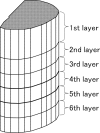Flexion model simulating spinal cord injury without radiographic abnormality in patients with ossification of the longitudinal ligament: the influence of flexion speed on the cervical spine
- PMID: 20025151
- PMCID: PMC2792461
- DOI: 10.1080/10790268.2009.11754557
Flexion model simulating spinal cord injury without radiographic abnormality in patients with ossification of the longitudinal ligament: the influence of flexion speed on the cervical spine
Abstract
Background/objective: It is suspected that the speed of the motion of the spinal cord under static compression may be the cause of spinal cord injury (SCI). However, little is known about the relationship between the speed of the motion of the spinal cord and its stress distributions. The objective was to carry out a biomechanical study of SCI in patients with ossification of the longitudinal ligament without radiologic evidence of injury.
Methods: A 3-dimensional finite element spinal cord model was established. After the application of static compression, the model underwent anterior flexion to simulate SCI in ossification of the longitudinal ligament patients without radiologic abnormality. Flexion of the spine was assumed to occur at 1 motor segment. Flexion angle was 5 degrees, and flexion speeds were 0.5 degrees/s, 5 degrees/s, and 50 degrees/s. Stress distributions inside of the spinal cord were evaluated.
Results: Stresses on the spinal cord increased slightly after the application of 5 degrees of flexion at a speed of 0.5 degrees/s. Stresses became much higher at a speed of 5 degrees/s and increased further at 50 degrees s.
Conclusions: The stress distribution of the spinal cord under static compression increased with faster flexion speed of the spinal cord. High-speed motion of the spinal cord under static compression may be one of the causes of SCI in the absence of radiologic abnormality.
Figures





Similar articles
-
Cervical ossification of the posterior longitudinal ligament: Biomechanical analysis of the influence of static and dynamic factors.J Spinal Cord Med. 2015 Sep;38(5):593-8. doi: 10.1179/2045772314Y.0000000221. Epub 2014 Jun 25. J Spinal Cord Med. 2015. PMID: 24964955 Free PMC article.
-
Influence of sagittal and axial types of ossification of posterior longitudinal ligament on mechanical stress in cervical spinal cord: A finite element analysis.Clin Biomech (Bristol). 2015 Dec;30(10):1133-9. doi: 10.1016/j.clinbiomech.2015.08.013. Epub 2015 Aug 29. Clin Biomech (Bristol). 2015. PMID: 26351002
-
Increased stress and strain on the spinal cord due to ossification of the posterior longitudinal ligament in the cervical spine under flexion after laminectomy.Proc Inst Mech Eng H. 2017 Sep;231(9):898-906. doi: 10.1177/0954411917718222. Epub 2017 Jun 29. Proc Inst Mech Eng H. 2017. PMID: 28660796
-
Does surgical treatment increase the progression of spinal cord injury in patients with ossification of posterior longitudinal ligament of cervical spine? A systematic review and meta-analysis.J Orthop Surg (Hong Kong). 2021 Jan-Apr;29(1):2309499020981782. doi: 10.1177/2309499020981782. J Orthop Surg (Hong Kong). 2021. PMID: 33410375
-
[Updates on ossification of posterior longitudinal ligament. Clinical results and problems of posterior decompression for OPLL of the cervical spine].Clin Calcium. 2009 Oct;19(10):1493-8. Clin Calcium. 2009. PMID: 19794259 Review. Japanese.
Cited by
-
Biomechanical study of the spinal cord in thoracic ossification of the posterior longitudinal ligament.J Spinal Cord Med. 2011;34(5):518-22. doi: 10.1179/2045772311Y.0000000029. J Spinal Cord Med. 2011. PMID: 22118260 Free PMC article.
-
Finite Element Analysis for Degenerative Cervical Myelopathy: Scoping Review of the Current Findings and Design Approaches, Including Recommendations on the Choice of Material Properties.JMIR Biomed Eng. 2024 Mar 28;9:e48146. doi: 10.2196/48146. JMIR Biomed Eng. 2024. PMID: 38875683 Free PMC article.
-
Mechanical properties of nerve roots and rami radiculares isolated from fresh pig spinal cords.Neural Regen Res. 2015 Nov;10(11):1869-73. doi: 10.4103/1673-5374.170319. Neural Regen Res. 2015. PMID: 26807127 Free PMC article.
-
Finite element modeling of the human cervical spinal cord and its applications: A systematic review.N Am Spine Soc J. 2023 Jul 27;15:100246. doi: 10.1016/j.xnsj.2023.100246. eCollection 2023 Sep. N Am Spine Soc J. 2023. PMID: 37636342 Free PMC article. Review.
-
Cervical ossification of the posterior longitudinal ligament: Biomechanical analysis of the influence of static and dynamic factors.J Spinal Cord Med. 2015 Sep;38(5):593-8. doi: 10.1179/2045772314Y.0000000221. Epub 2014 Jun 25. J Spinal Cord Med. 2015. PMID: 24964955 Free PMC article.
References
-
- Ueta T, Shiba K, Katsuki M. Mechanism of injury and instability of cervical cord injuries without radiological remarkable XP evidence of injury [in Japanese] Rinsho Seikeigeka. 1989;24:483–490.
-
- Mihara K, Torigoshi T, Konishi H. Cervical spinal cord injury with ossification of the posterior longitudinal ligament [in Japanese] Seikeigeka to Saigai Geka. 1991;40:763–765.
-
- Kato Y, Kataoka H, Ichihara K. Biomechanical study of cervical flexion myelopathy using a three-dimensional finite element method. J Neurosurg Spine. 2008;8(5):436–441. - PubMed
-
- Tunturi AR. Elasticity of the spinal cord, pia and denticulate ligament in the dog. J Neurosurg. 1978;48:975–979. - PubMed
-
- Okano T, Sakou T, Taketomi E, Matsunaga S, Ijiri K, Iwao S. Natural history of ossification of posterior longitudinal ligament [in Japanese] J West Jpn Res Soc. 1994;20:83–86.
MeSH terms
LinkOut - more resources
Full Text Sources
Medical
